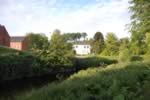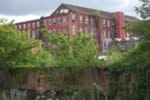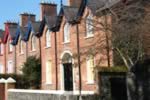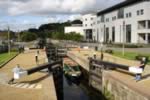Clement Wilson/Newforge Foods
Robert Clement Wilson was originally from Scotland and when he had an argument with his father about business methods, he was challenged to set up his own. He moved to Newforge. The site of his factory is where the Department of Agriculture offices are now at the bottom of Newforge Lane. They produced canned foods and were well known for their canned Ulster Fry. There was also a pet food cannery where they produced Kennomeat and Kattomeat.
Clement Wilson was very forward thinking and was constantly bringing in new ideas and technologies. It was the first factory to have a health centre for employees, tennis courts and pleasure gardens. Clement Wilson Park was the site of the factorys vegetable gardens and piggeries.
John Shaw Brown/Edenderry
There had been a bleachworks on the site since the late 1700s which had later been turned into a flour mill. John Shaw Brown acquired the flour mill at Edenderry converting the existing premises to a weaving factory and erecting another large weaving shed.
The factory, known as the St. Ellen Works, developed from 1866 onwards into a successful enterprise, trading under the name of John Shaw Brown and Sons.
The site which John Shaw acquired extended to 46 acres of rich pasture bounded by clusters of mature trees. The Russells had built their bleachworks on the low lying land close to the riverbank harnessing the water power in a mill dam and race. From 1866 onwards houses which formed the village were built on the level above the factory buildings in a cul-de-sac surrounded by an attractive landscape of hills and mature trees boarded by the river.
Richardson, Sons and Owden
The Richardson family were one of the biggest linen families and owned a number of mills, bleachworks and warehouses covering all aspects of the linen trade. They had extensive bleachworks at Glenmore, beside Lambeg.
Lambeg Bleaching Dying and Finishing Company
There had been a bleaching green on the site since 1626. The site was eventually taken over by Coca Cola who turned it into a bottling plant.
Hilden
Louis Crommelin, a French Huguenot who settled in Lisburn in 1700, is largely credited with the development of the linen industry in Ulster in the early 18th century. He set up a bleachworks in Hilden in the early 1700s.
In 1784 John Barbour, who came from Scotland, established a linen thread works in Lisburn. At the same time his son, William, bought a derelict bleach green at Hilden and set up business. Later, the thread works were transferred to Hilden and as early as 1817 it was employing one hundred and twenty-two workers. In 1823 William Barbour bought a former bleach mill at Hilden and built a water-powered twisting mill. The Linen Thread Company was founded 1898 and it quickly became a large international company.
By 1914 it employed about 2,000 people and it was the largest thread-making works in the world.
The company built a model village for its workforce in Hilden, which consisted of three hundred and fifty houses, two schools, a community hall, children's playground and village sports ground.
Another of John Barbours sons, Thomas, was a founder of the linen thread industry in the USA.

Lagan Valley Island
In 1760 Messrs Thomas Gregg and Waddell Cunningham built a vitriol factory on the island that had been created by building the canal. It produced vitriol or sulphuric acid which was used to bleach the brown linen white. This greatly speeded up the process of producing the linen. The island was named 'Vitriol Island' after it. In 1840 it was purchased by the Richardsons who changed it to the manufacture of linen and thread. In 1867 they set up the world famous Island Spinning Company.

Coulson's
In 1764 William Coulson established a handloom damask manufactory. Damask linen was woven with an intricate pattern and damask weavers were the elite. Coulson's was an early factory before this most weaving was done in the home. The cloth was finished at a nearby bleach yard until 1823 when a bleachworks was built at Sprucefield. Between 1823 and 1826, the Coulsons of Lisburn and Michael Andrews of Ardoyne introduced the Jacquard machine (invented by Louis Jacquard of Lyons in France in the year 1801). The figured design was punched on strips of cardboard laced together to form an endless chain. This machine might be said to be the mechanical forerunner of the computer. Coulson's reputation was for the highest quality linen was sealed when Queen Charlotte, wife of George III, ordered a full set of table linen from them. The nobility of Britain and Ireland and other countries then ordered their linen from Coulson's.







